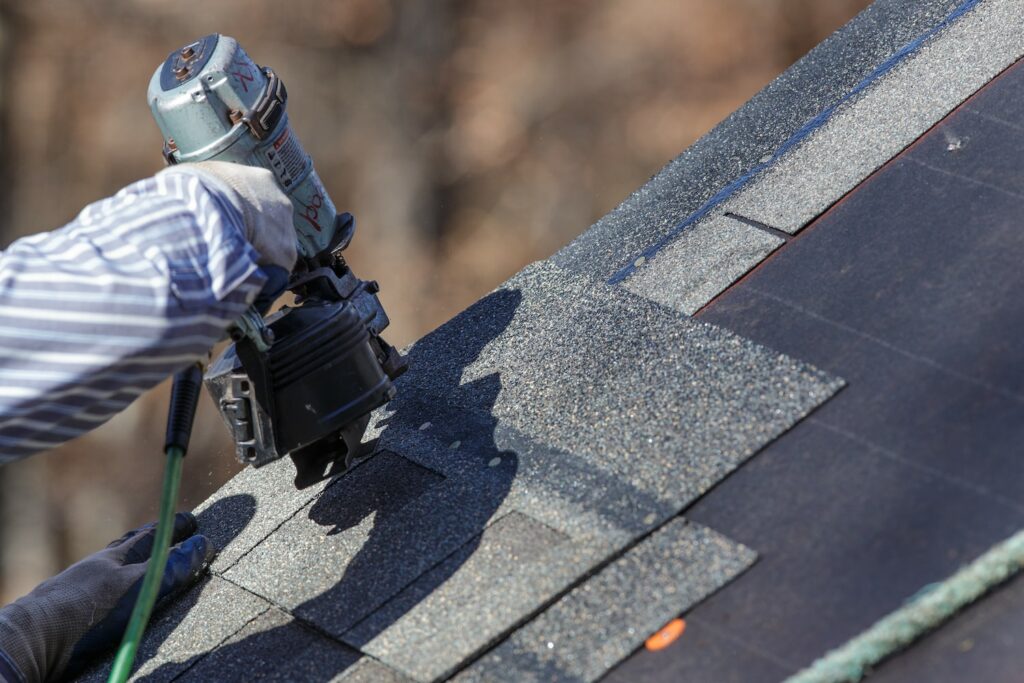Seasonal Roof Fixing Checklist: Prepare Your Roof for Every Weather
To prepare your roof covering for every single weather condition period, start with an extensive assessment prior to wintertime. Look for missing out on tiles and put on around smokeshafts. As springtime gets here, make particular all rain gutters are tidy and inspect for loose floor tiles. Summer season maintenance need to concentrate on air flow and granule loss on tiles. Come loss, clear seamless gutters again and visually evaluate for any type of indicators of wear. Knowing common roofing system problems and when to call a professional can help extend your roof covering's life-span.
Evaluating Your Roof Before Winter
As wintertime strategies, it's critical to check your roofing completely to avoid costly damage. Start by looking for missing or damaged shingles; even a tiny problem can lead to bigger troubles when snow and ice accumulate. Search for signs of wear around smokeshafts, vents, and blinking, as these areas are usually vulnerable to leakages.
Next, analyze the gutters and downspouts. Validate they're clear of particles, as stopped up gutters can cause water to back up and damage your roofing system. Take notice of any kind of drooping locations, which can show structural concerns needing prompt interest.
Don't forget to examine your attic room for signs of water damages or mold, which might indicate a roof leakage. If you detect any type of major issues, it's sensible to seek advice from a specialist for repairs. Taking these actions will certainly assist ensure your roof stands up to the severe wintertime months ahead.
Preparing Your Roofing System for Spring Showers
Beginning by examining your roof covering for any type of loosened shingles or floor tiles. Next, clean out downspouts and seamless gutters to guarantee correct drain; stopped up gutters can lead to water pooling and roofing system damage.
Look for any signs of damages, like fractures in the flashing or locations where water may accumulate. If you see anything worrying, it's ideal to address it currently instead of wait on the very first downpour.
Also, think about trimming overhanging tree branches to minimize the risk of them falling on your roofing system during tornados. Finally, if your roofing is older, think of setting up a specialist examination. Taking these steps currently will help you stay clear of expensive fixings later on and maintain your home completely dry and risk-free this spring.
Summertime Maintenance Tips for Your Roofing
As summer approaches, it's a fun time to give your roof some extra attention. You must examine for roof shingles damage, clean your gutters completely, and check your air flow systems to guarantee every little thing's in leading form. Taking these actions currently can conserve you migraines later on.
Check for Roof Shingles Damage
While summer brings longer days and warmer weather, it's also the perfect time to examine your roof for shingle damages. Begin by searching for missing out on, cracked, or curling roof shingles, as these can allow water seep in and trigger significant concerns. Take note of the ridges and sides, where wear is often a lot more obvious. If you identify any type of damage, it's necessary to address it quickly to protect against leaks and further wear and tear. Do not fail to remember to examine for granule loss, which can show that your roof shingles are maturing. Remember, a properly maintained roof not just protects your home however likewise enhances its aesthetic allure. By taking these steps currently, you'll assure your roofing continues to be trusted and solid throughout the summer and beyond.
Clean Seamless Gutters Thoroughly
Cleansing your seamless gutters extensively is essential for keeping your roof covering's health and wellness throughout the summertime months. Stopped up rain gutters can bring about water backup, creating potential damage to your roofing and home. Start by removing fallen leaves, branches, and debris from the gutters making use of an inside story or your hands while putting on gloves. When removed, flush the seamless gutters with water to guarantee correct drain. Inspect downspouts for clogs, and ensure water flows openly away from your structure. Take into consideration using a garden hose with a spray nozzle to displace stubborn blockages if needed. Frequently cleaning your gutters not only avoids roofing damages yet additionally secures your home from mold and mildew. Stay proactive to keep your roof in leading shape this summer!
Inspect Air Flow Equipments
To guarantee your roof covering remains in peak problem during the summertime, inspecting your air flow systems is important. Correct air flow assists manage your attic's temperature, preventing heat build-up that can lead to damage. Start by inspecting your roofing system's vents, guaranteeing they're not obstructed by particles or insulation. Try to find any signs of rust or degeneration, as these can compromise functionality. Make sure they're unblocked to allow fresh air flow if your roofing has soffit vents. If you do not have ample air flow, consider setting up ridge vents. Examine your attic for appropriate air movement; a well-ventilated attic room can greatly decrease cooling down costs. By keeping your ventilation systems, you'll boost your roofing system's life-span and maintain your home comfy all summer long.
Autumn Assessment: Preparing for Winter Season
As autumn strategies, it's vital to check your roof covering for any kind of loose shingles that can be susceptible to wintertime weather. Don't fail to remember to get rid of out rain gutters and particles to ensure appropriate drain and stop ice dams. Taking these actions now can conserve you from bigger headaches later on.
Inspect for Loose Shingles
Prior to wintertime sets in, it's necessary to check your roofing system for loosened roof shingles, because these can result in major concerns when snow and ice build up. Begin by aesthetically analyzing your roofing system from the ground. Look for any kind of tiles that appear misplaced, broken, or missing out on. Check for any kind of indications of wear or damages up close if you can securely get onto your roofing. Carefully raise each tile to see if it's safeguarded effectively. If you discover loose ones, reattach them or replace them as needed. Pay special interest to the roofing edges and valleys, where wind can displace tiles extra quickly. When winter season weather hits., taking these steps now can save you from pricey repair services later on.
Clear Rain Gutters and Particles
Clearing rain gutters and removing debris is a crucial step in preparing your roofing check here system for winter season. Clogged up rain gutters can result in water back-up, creating ice dams that damage your roof and home. Begin by utilizing a strong ladder to access your gutters safely. Eliminate leaves, branches, and any various other debris that's collected. Do not neglect to inspect downspouts, guaranteeing they're clear and directing water far from your foundation. Think about changing the slope of your gutters if you discover any areas where water often tends to pool. Once whatever's tidy, flush the seamless gutters with water to check for correct drainage. Taking these actions now will help prevent costly repair work down the line and keep your roof in great shape throughout the wintertime season.
Cleaning up and Cleaning Rain Gutters and Downspouts
While you might not assume about gutters and downspouts regularly, keeping them clean is important for preserving your roofing system's wellness. Clogged up gutters can lead to water buildup, which can harm your roof covering and foundation.
As soon as you see the build-up, scoop it out utilizing your hands or a tiny trowel. A yard tube can assist purge it out if you experience stubborn cruds. Do not neglect to inspect the downspouts; ensure they're clear so water can stream easily.
If you notice any kind of clogs, utilize a plumbing serpent or a high-pressure nozzle to clear them. Routine cleaning, preferably twice a year, keeps your rain gutters operating appropriately and prevents pricey repair work down the line. Your roof will certainly thank you for the initiative!
Determining Common Roof Issues by Period
As the seasons adjustment, it's essential to remain alert about your roofing system's condition, since each period brings its own set of challenges. In winter months, expect ice dams that can create water to support under shingles, causing leakages. Spring usually brings hefty rains, so inspect for missing out on roof shingles and look for water pooling.
Summertime's warmth can bring about fractured roof shingles or blistering, so watch out for signs of wear. Autumn's falling fallen leaves can block gutters and trap wetness, boosting the risk of mold and degeneration.
 roof repair
roof repair
When to Call an Expert Roofing Contractor
If you discover missing out on tiles, water discolorations on your ceiling, or leakages throughout a rainstorm, it's time to reach out for aid. Don't ignore the dangers of climbing up on your roofing system yourself, specifically if you do not have experience.
If your roof covering is over 20 years old or shows substantial damage, seeking advice from an expert is smart. They can examine whether repair work or a full substitute is necessary. In addition, after severe weather occasions like storms or hailstorm, get a specialist to check for surprise damage.
When your DIY initiatives transform into irritation or if you're not sure concerning a repair work, calling a roofer can stop additional damages. Bear in mind, buying expert help can expand your roof covering's life-span and assure your home keeps shielded.
Regularly Asked Questions
How Frequently Should I Examine My Roofing System Throughout the Year?
You ought to inspect your roof covering at the very least two times a year, preferably in springtime and fall. Routine checks aid you catch possible problems early, ensuring your roofing system remains in good condition and protects your home efficiently.
What Devices Do I Required for Roof Covering Inspections?
For roof evaluations, you'll require a strong ladder, harness, flashlight, and field glasses. A wetness meter and a tape step can also aid you analyze any type of damage effectively. Do not neglect gloves for defense!
Can I Repair My Roof Myself or Should I Work with a Professional?
If you're certain and have the right devices,You can repair your roof on your own. Nevertheless, if you're unsure or the damage is substantial, hiring an expert guarantees security and quality outcomes. Don't think twice to request aid!
If My Roofing System Demands Changing?, just how Do I Know.
You'll recognize your roof covering needs replacing if you see considerable leaks, curling tiles, or granule loss. It's time to ponder a replacement prior to additional damages takes place. if it's over 20 years old or noticeably drooping.
What Are the Indications of Roof Damages After a Storm?
 roof repair
roof repair
Seasonal Roofing System Repair Service List: Prepare Your Roofing for Every Climate
Knowing regarding common roofing problems and when to call a professional can assist lengthen your roof's life expectancy.
Confirm they're clear of debris, as stopped up seamless gutters can cause water to back up and damage your roof covering. Next off, tidy out seamless gutters and downspouts to assure proper water drainage; blocked gutters can lead to water merging and roofing damage.
Clogged gutters can lead to water backup, causing potential damages to your roofing and home.